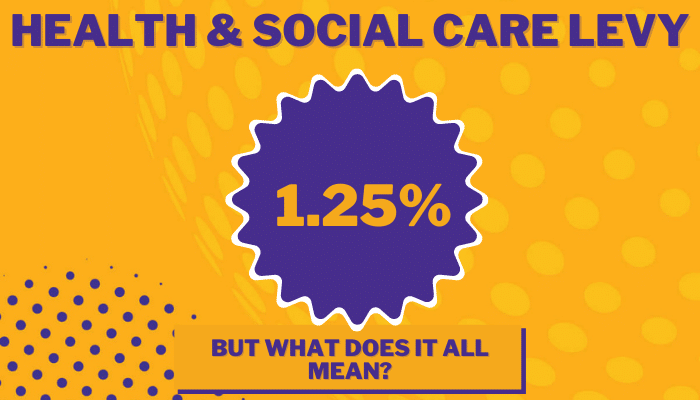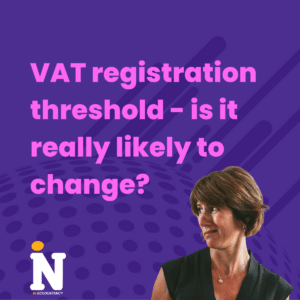Health and Social Care Levy: The facts so far, who will be impacted and how, as well as what we don’t know yet
The Government recently announced their plans to raise an extra £12bn per annum for health and social care by introducing a 1.25% Health and Social Care Levy to all rates of National Insurance Contributions and income tax on dividends.
What exactly will happen and when?
From 6 April 2022, all rates of NIC, except for class 2 and class 3, as well as dividend tax rates, will increase by 1.25%.
From 6 April 2023, the increase to National Insurance Contributions will be ‘rebranded’ as the Health and Social Care Levy and shown, and legislated for, separately to NICs
Why does it rebrand as a ‘Levy’ in 2023?
The Government wants this money to be shown and collected separately to regular NICs as it will be directly funneled into Health and Social Care reform and should be legislated for separately.
They would be unable to show this separately from it’s introduction in April 2022 as current tax and payroll software need more time to be able to reconfigure their systems and report.
Who will be impacted by the Health and Social Care Levy?
From 6 April 2022 anyone who currently pays NIC or tax on dividend income will be impacted.
Specifically this means any individual who earns more than £9,568 via Pay as you Earn or from Self-Employment and currently pays NIC.
It will also impact companies who pay Employers Class 1 NIC on staff wages above £8,840 per person per annum.
Company shareholders who currently remunerate themselves by dividend will also see the tax on this dividend increase by 1.25%
From April 2023 the rebrand to a separate Levy means that any individuals who are over the state pension age but still working will pay a health and social care tax at 1.25% on any earnings above £9,568
Impact for Employees and Employers
Employees and Employers Class 1 NICs:
| Class 1 Primary (employee) | 2021/22 | 2022/23 |
| 0–£9,568 | 0% | 0% |
| £9,568–£50,270 | 12% | 13.25% |
| Above £50,270 | 2% | 3.25% |
| Class 1 secondary (employer) | ||
| 0–£8,840 | 0% | 0% |
| Above £8,840 | 13.8% | 15.05% |
| Class 1A | 13.8% | 15.05% |
| Class 1B | 13.8% | 15.05% |
A person on the minimum wage of £8.91 per hour starts to pay class 1 NIC if they work more than 17.4 hours per week and pays income tax if they work more than 27.13 hours per week.
Self Employed:
Class 4:
| 2021/22 | 2022/23 | |
| 0–£9,568 | 0% | 0% |
| £9,568–£50,270 | 9% | 10.25% |
| Above £50,270 | 2% | 3.25% |
So, a self-employed individual currently making a profit of £30,000 per annum will see their Class 4 NIC increase from £1,838.88 to £2,094.28 = £255.40 pa more or an 13.9% increase.
This percentage increase grows larger on individuals earning more than the Higher Rate threshold. For example, someone earning £60,000 profit pays 16.3% more NIC and for someone on £150,000 their increase in NIC is almost 31%!
It is expected that additional rate tax payers, who amount to around 2% of the population, will contribute about 20% of the H&SC revenue from National Insurance Contributions
Business Owners and Shareholders
| Dividend tax | 2021/22 | 2022/23 |
| Dividend allowance | £2,000 | £2,000 |
| Basic rate band | 7.5% | 8.75% |
| Higher rate band | 32.5% | 33.75% |
| Additional rate band | 38.1% | 39.35% |
Additional and higher rate dividend tax payers are expected to contribute more than 70% of revenue from this source in 2022-23. And this is before the planned increase in corporation tax is taken into account – see below.
What else is there to consider?
Scottish Tax Payers
If you’re a Scottish tax payer, earning between £43,663 and £50,270, WATCH OUT – you will see a marginal rate of tax of 54.25% on earned income in this band, as opposed to 33.25% for tax payers in the rest of the UK.
Basis Period Reform
The 2022/23 tax year is also currently looking likely to be the transition period between the current year basis and proposed tax year basis, meaning that if you are a sole trader or partnership with accounting period year ends falling outside of the 31 March or 5 April dates, then you will have more than 12 months’ profits being taxed (both for income and NIC) in that year!!
For further details on the Basis Period Reform Consultation and what this might mean to you and your business, please see our earlier article here:
Corporation Tax Increase
Limited Company owners also need to consider and budget for an increase in corporation tax from 1 April 2023 when the main rate jumps from 19% to 25% for profits over £50,000!
Zero rated secondary class 1 NICs
It has been confirmed that the HSC Levy will not be payable by the employer on employee’s wages where this applies, including:
- Anyone under 21
- Apprentices under 25
- Ex-forces personnel in their first civilian role for the first 12 months
Employment Allowance
In the 2022/23 tax year, HMRC has confirmed that the employment allowance can be offset against the increased rate of secondary class 1 NICs, AND that the Employment Allowance will also apply to the Levy from the 2023/24 tax year.
Dividend Tax
While the Government has confirmed that dividend tax will remain at the increased levels from 6 April 2023, we do not yet know whether the £2000 Dividend Allowance will remain in place.
What do we still not know?
There are other areas which may be impacted, but we do not yet have confirmation or clarification from the Government or HMRC as to how they will be treated, as follows:
Section 455
This is a tax currently paid by directors / shareholders in limited companies on any overdrawn directors’ loan account (DLA) at 32.5%. It is likely that this will increase in line with the tax on dividends to 33.75% from 6 April 2022
Universal Credit
In 2022/23 Universal Credit claimants will have their benefit topped up to compensate for some of the loss of income resulting from this increase, however it is not clear whether the HSC Levy will be treated in the same ways as NIC for Universal Credit purposes – Universal Credit entitlement is currently worked out AFTER income tax and NIC deductions have been taken into account.
Thresholds
While it has been confirmed that the upper earning limit of £50,570, which is aligned with the income tax higher rate threshold, is to be frozen at this level until 6 April 2026, it is not yet known whether the primary and secondary thresholds will also be held at those levels for the same period.
The primary threshold of £9,568 is the level at which employees and the self-employed start paying NIC, class 1 and class 4 respectively. The secondary threshold of £8,840 is the level at which employers start paying class 2 NIC for their employees
As has been par for the course recently, there is a great deal to take in. If you have any questions regarding this, or other issues affecting your business, please do not hesitate to contact the IN Team, who will be happy to help.
For further reading, you can access the Policy Paper entitled ‘Build Back Better: Our Plan for Health and Social Care’ here.







